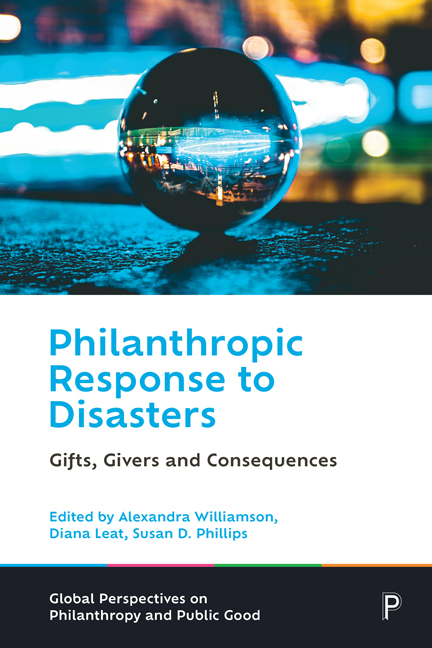Book contents
- Frontmatter
- Contents
- List of tables and figures
- Notes on contributors
- Series editors’ preface
- 1 Introduction
- 2 The public’s philanthropic response to disaster: plus ça change?
- 3 Disaster fundraising: readiness matters
- 4 Roles of philanthropic foundations as funders and distribution agents in disaster response
- 5 The private sector and disasters: from reactive response to disaster resilience
- 6 Fundraising, grantmaking and regulatory issues: regulating good in bad times
- 7 Doing good better: public policy for disaster philanthropy
- 8 Philanthropy’s place in community-based capacity development for disaster resilience
- 9 Nonprofit collaboration and coordination in disaster response: lessons from the 11 September recovery
- 10 The promise and reality of philanthropy in disasters
- 11 Conclusions and looking forward
- Index
9 - Nonprofit collaboration and coordination in disaster response: lessons from the 11 September recovery
Published online by Cambridge University Press: 17 January 2024
- Frontmatter
- Contents
- List of tables and figures
- Notes on contributors
- Series editors’ preface
- 1 Introduction
- 2 The public’s philanthropic response to disaster: plus ça change?
- 3 Disaster fundraising: readiness matters
- 4 Roles of philanthropic foundations as funders and distribution agents in disaster response
- 5 The private sector and disasters: from reactive response to disaster resilience
- 6 Fundraising, grantmaking and regulatory issues: regulating good in bad times
- 7 Doing good better: public policy for disaster philanthropy
- 8 Philanthropy’s place in community-based capacity development for disaster resilience
- 9 Nonprofit collaboration and coordination in disaster response: lessons from the 11 September recovery
- 10 The promise and reality of philanthropy in disasters
- 11 Conclusions and looking forward
- Index
Summary
Disasters require a collaborative approach to recovery, bringing together public and private resources to address needs. In the United States (US), this consists of a mixture of federal, state and local government agencies working with national and local nonprofit organisations. The US relies upon nonprofit organisations to provide relief and recovery services, much like US social services rely upon nonprofits to deliver services (Federal Emergency Management Agency (FEMA), 2011). On 11 September 2001, hijacked planes were piloted into the World Trade Center in New York City, the Pentagon in Washington, DC, and into a field in Shanksville, Pennsylvania. The attacks transformed many parts of American society and life, especially related to disaster response. This chapter analyses two essential aspects of the nonprofit response to disasters in the US: fundraising and coordination of services. The event led to the creation of a collaborative fundraising arm, the September 11th Victim Compensation Fund (hereafter, the September 11th Fund), and the direct coordination of services through a nonprofit organisation formed specifically to coordinate the disaster recovery programme, the 9/ 11 USG.
The nonprofit response to the 11 September attacks illustrated how nonprofit organisations play a role in disaster response even when there is strong government engagement. The September 11th Fund was established in 2001 and granted approximately US$7 billion over the next three years to compensate those who were physically injured or who lost family members in the attacks (Feinberg, 2005). In addition, Congress awarded US$20 billion to clean-up and redevelop the areas attacked (GAO, 2003). Private insurance added additional billions (September 11th Fund estimate). Yet the tremendous outpouring of support from individuals and institutions in the immediate aftermath of the attacks preceded government action, and, over time, the nonprofit sector became more important in addressing the long-term needs of individuals impacted by this major disaster. In terms of funding, the 9/ 11 attacks generated so many donations that even though there was a strong attempt to create a singular fund, the September 11th Fund, Americans created hundreds of funds to support 9/ 11 services. Public pressure from media and government officials placed an emphasis on quick dispersal of funds but also a call for the efficient use of them. While the call for funding collaboration preceded this public pressure, the nonprofit organisation of service provision was in reaction to these outside forces.
- Type
- Chapter
- Information
- Philanthropic Response to DisastersGifts, Givers and Consequences, pp. 186 - 200Publisher: Bristol University PressPrint publication year: 2023

